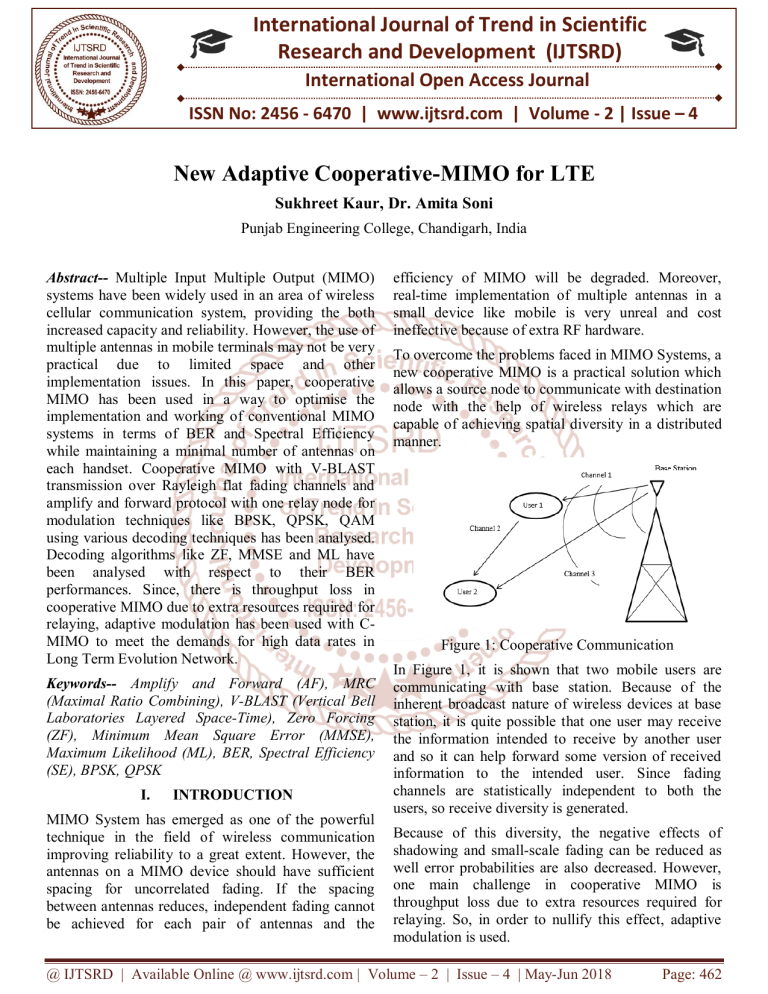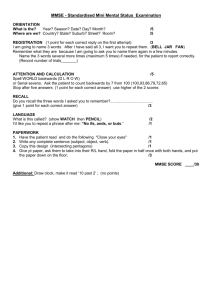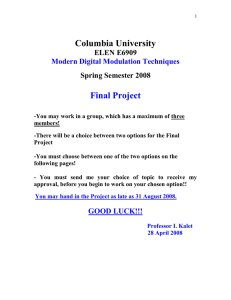
International Journal of Trend in Scientific
Research and Development (IJTSRD)
International Open Access Journal
ISSN No: 2456 - 6470 | www.ijtsrd.com | Volume - 2 | Issue – 4
New Adaptive Cooperative-MIMO for LTE
Sukhreet Kaur, Dr. Amita Soni
Punjab Engineering College, Chandigarh, India
Abstract-- Multiple Input Multiple Output (MIMO)
systems have been widely used in an area of wireless
cellular communication system, providing the both
increased capacity and reliability. However, the use of
multiple antennas in mobile terminals may not be very
practical due to limited space and other
implementation issues. In this paper, cooperative
MIMO has been used in a way to optimise the
implementation and working of conventional MIMO
systems in terms of BER and Spectral Efficiency
while maintaining a minimal number of antennas on
each handset. Cooperative MIMO with V-BLAST
transmission over Rayleigh flat fading channels and
amplify and forward protocol with one relay node for
modulation techniques like BPSK, QPSK, QAM
using various decoding techniques has been analysed.
Decoding algorithms like ZF, MMSE and ML have
been analysed with respect to their BER
performances. Since, there is throughput loss in
cooperative MIMO due to extra resources required for
relaying, adaptive modulation has been used with CMIMO to meet the demands for high data rates in
Long Term Evolution Network.
Keywords-- Amplify and Forward (AF), MRC
(Maximal Ratio Combining), V-BLAST (Vertical Bell
Laboratories Layered Space-Time), Zero Forcing
(ZF), Minimum Mean Square Error (MMSE),
Maximum Likelihood (ML), BER, Spectral Efficiency
(SE), BPSK, QPSK
I.
INTRODUCTION
MIMO System has emerged as one of the powerful
technique in the field of wireless communication
improving reliability to a great extent. However, the
antennas on a MIMO device should have sufficient
spacing for uncorrelated fading. If the spacing
between antennas reduces, independent fading cannot
be achieved for each pair of antennas and the
efficiency of MIMO will be degraded. Moreover,
real-time implementation of multiple antennas in a
small device like mobile is very unreal and cost
ineffective because of extra RF hardware.
To overcome the problems faced in MIMO Systems, a
new cooperative MIMO is a practical solution which
allows a source node to communicate with destination
node with the help of wireless relays which are
capable of achieving spatial diversity in a distributed
manner.
Figure 1: Cooperative Communication
In Figure 1, it is shown that two mobile users are
communicating with base station. Because of the
inherent broadcast nature of wireless devices at base
station, it is quite possible that one user may receive
the information intended to receive by another user
and so it can help forward some version of received
information to the intended user. Since fading
channels are statistically independent to both the
users, so receive diversity is generated.
Because of this diversity, the negative effects of
shadowing and small-scale fading can be reduced as
well error probabilities are also decreased. However,
one main challenge in cooperative MIMO is
throughput loss due to extra resources required for
relaying. So, in order to nullify this effect, adaptive
modulation is used.
@ IJTSRD | Available Online @ www.ijtsrd.com | Volume – 2 | Issue – 4 | May-Jun 2018
Page: 462
International Journal of Trend in Scientific Research and Development (IJTSRD) ISSN: 2456-6470
This paper analyses the BER and Spectral Efficiency
of the cooperative MIMO system aided by adaptive
modulation scheme over the Rayleigh fading channel
under perfect CSI.
II.
RELATED WORK
Many researches have been done focussing on
Adaptive modulation in Cooperative MIMO finding a
way to improve spectral efficiency. In [9], a new joint
adaptive modulation and MIMO transmission
algorithm has been studied under imperfect CSI. In
[10], various AM schemes have been studied in
MIMO-OSTBC to analyse the performance of
Variable-power Adaptive Modulation with imperfect
CSI. In [11], adaptive modulation for OFDM system
over frequency selective fast fading channel was
studied. The performance analysis of adaptive
modulation in MIMO system-based Imperfect CSI
showed that significant gains can be achieved with
rate adaptation even with imperfect CSI in [12]. A
novel hybrid Cooperative AMC mechanism is
suggested by authors in [14] for improving hybrid
link quality. Therefore, adapting constellation size of
transmitted signal to changing channel conditions can
track the wireless channel properties and thus sending
more bits in good channel state and less bits in poor
channel state can help increasing spectral efficiency.
III.
COOPERATIVE TRANSMISSION
PROTOCOLS
Few common relaying protocols are:
2. Minimum Mean Square Error (MMSE): This
performs better than the ZF under noisy conditions. It
is not able to discard ISI like ZF but however, it
reduces the total noise power received at the receiver
side. The MMSE filter is calculated by minimizing
the mean-square error (MSE) as: WMMSE = (HTH +
σ2IN)-1HT where σ is Ratio of received signal power
to noise power and IN is Identity matrix.
3. Maximum Likelihood (ML): The decision is
taken according to the minimum Euclidean distance
between the received signal vector and the product of
all possible transmitted signal vectors with channel H,
and one with the least distance is found.
V.
COMBINING TECHNIQUES
Incoming signals with same information have to be
combined if more than one in number. Some of these
combining techniques are:
Maximum Ratio Combining (MRC), Equal Gain
Combiner, Fixed Ratio Combining, Signal to Noise
Ratio Combining, Estimated SNR Combining In this
paper, MRC scheme is used. In MRC, each radio
channel is weighted with the complex conjugate of the
respective channel gain assuming that channels' phase
shift and attenuation is perfectly known at the
receiver.
VI.
COOPERATIVE MIMO OVER
RAYLEIGH FADING CHANNEL
SIMULATION MODEL
1. Amplify and Forward - In AF, received signal is
scaled at relay node and transmitted to end user node
after amplification.
2. Decode and Forward - In DF, the received signal
is first decoded and then re-encoded. So, there is no
amplified noise in received signal at end node.
3. Compress and Forward - In CF, a signal is
quantized and compressed by relay and then
forwarded to user node.
IV.
DETECTION TECHNIQUES FOR MIMO
SYSTEM
Objective of the detection - to differentiate the
transmitted signals on the basis of observation of the
received signal vector and the channel matrix.
1. Zero-Forcing: ZF nullifies the interference by
WZF matrix, which is the pseudo inverse of channel
matrix H i.e. WZF = (𝐇𝐓𝐇)-1 HT.
Figure 2: System Model of Cooperative MIMO
To evaluate the performance of Cooperative MIMO,
all nodes are placed at equal distance with Ns=Nr=
Nd=2 as shown in Fig 2 where Ns, Nr, Nd are number
of antennas at source, relay and destination
respectively such that Nd ≥Ns=Nr in order to separate
and detect the x transmitted signals. Thus, a block
fading half-duplex channel model with N fading
blocks is assumed here, with L symbol periods in each
@ IJTSRD | Available Online @ www.ijtsrd.com | Volume – 2 | Issue – 4 | May-Jun 2018
Page: 463
International Journal of Trend in Scientific Research and Development (IJTSRD) ISSN: 2456-6470
block. On each block, Fading is assumed to be flat
and constant but independently Rayleigh distributed
on different blocks. Further, Average power is fixed
per user due to uniform energy distribution with an
assumption of perfect CSI available at the receiver
side only.
There are two phases in which communication occurs.
In phase one, the signal transmitted by source
undergoes fading and is sent to relay. In phase two,
depending upon the relay protocol, transceiver
complexity, relative channel conditions and also user
location, relay cooperate with the destination node. In
this paper, Amplify and Forward protocol with
variable relay gain is considered.
The equivalent cooperative MIMO NdNr x Ns (4x2)
with NdNr (2) virtual receiving antennas
representation for the proposed MIMO system using
relays is given as:
Where yd,1 nl and yd,2 nl are the received signals at
the user end during the phase one and phase two
respectively, Es is the average power per antenna of
each symbol at the source. Hsrnl and Hsdnl denotes
the nth block fading channel matrix of source-relay
and source-destination link respectively. The vectors
nsrnl and nsdnl are the noise due to source transmit
the signal to relay and destination respectively. Index
notation (nl) is used to emphasize more on the block
fading nature of channel. ∝nl is a gain factor of
variable gain relay. The transmit signal from relay is:
xrnl = αnlyrnl (2)
Therefore, the equivalent channel matrix for relayed
link is:
Heqrsdnl = Fnl = HrdnlHsrnl (3)
While equivalent noise at receiver side is:
neqrsdnl = Hrdnl αnl nsrnl + nrdnl (4)
After these two phases of cooperative transmission,
the signals received at destination will be combined
using one of the combining techniques discussed
above and as the two networks source-destination and
source-relay-destination links are different, so
independent combining is done and then estimated
values are summed up to get the final results.
VII.
COOPERATION BASED ON V-BLAST
TRANSMISSION
Cooperative VBLAST transmission achieves high
spectral efficiency by spatially multiplexing the coded
or uncoded symbols transmitted by source in first
phase over the fading channel. The received symbols
are modified by relay and forwarded to destination in
second phase. Using MRC technique, the total receive
signal at the destination is given as follows:
ynl = HHsdnl yd,1 nl + HeqrsdnlH yd,2 nl (5)
In order to detect the transmitted signal x, put y in ZF,
MMSE and ML detection scheme as y is in y = Hx +
n form.
VIII.
ADAPTIVE MODULATION IN
COOPERATIVE MIMO
The basic purpose of adaptive modulation is to apply
the modulation based on CSI (Channel State
Information) available. When the channel is in good
state, higher order modulation scheme is used,
otherwise lower order scheme is preferred. The
various parameters that can used to indicate the CSI
are SNR (Signal to Noise Ratio), SINR (Signal to
Noise Ratio plus Interference), PERs (Packet Error
Rates) or BER (Bit error Rate). In this paper, the post
detection of SNR at the output of ZF, MMSE and ML
detectors is used as a metric for CSI as it directly
measures the performance of communication system.
This post SNR will correspond to BER information
for each mode candidate and then threshold SNR is
selected depending on the mode that yields the highest
throughput remaining with BER constraints.
Since exact post SNR detection is impossible, it can
be estimated by sending pilot sequence through the
channel to have the knowledge of current CSI. In this
paper, it is assumed that CSI is known at receiver
terminal.
Adaptation based SNR in assisted cooperative AF
MIMO with VBLAST transmission
In order to select the suitable modulation scheme
based on the specified BER target, threshold SNR has
to be determined at the output of ZF, MMSE and ML
detectors for which it yields maximum throughput.
For that, post SNR equations has to be derived at the
output of these given detectors considering all direct
and non-direct links with V-BLAST transmission at
receiver only. In addition, the data streams are sent
@ IJTSRD | Available Online @ www.ijtsrd.com | Volume – 2 | Issue – 4 | May-Jun 2018
Page: 464
International Journal of Trend in Scientific Research and Development (IJTSRD) ISSN: 2456-6470
independently to the relay and destination nodes and
then collaboratively processed at destination to
recover the original signal.
The equivalent channel matrices for direct and relayed
links are given by Hsdnl and Fnl. For MRC technique
the receive signal is: ynl = (Σ√𝐸𝑠 𝑁𝑟 𝑖=1 ( |ℎ𝑖1 𝑑𝑠𝑛𝑙
|2 + |ℎ𝑖2 𝑑𝑠𝑛𝑙 |2) + 𝐸𝑠 4 ∝𝑛𝑙 ( |𝑓𝑖1 𝑛𝑙 |2 + |𝑓𝑖2 𝑛𝑙 |2)
xnl + 𝑛̃nl (6)
Where Fnl = HrdnlHsrnl and 𝑛̃nl is the equivalent
noise channel evaluated at the output of MRC that is
B. MMSE detection
In this scheme, the transmitted signal xnl can be
evaluated by minimizing the mean square error.
MMSE detection matrix is given as
𝑛̃nl = FH nl (Hrdαnl nsrnl + nrdnl) + HH sdnl (7)
In matrix form (6) can be written as:
Multiplying Eq. 8 by Eq. 14, the estimate signal is
u11nl = √𝐸(|h11 dsnl|2 + |h21 dsnl|2) + 𝐸𝑠 4 αnl ( |f11
nl|2 + |f21 nl|2)
u22 nl = √𝐸𝑠(|h12 dsnl|2 + |h22 dsnl|2) + 𝐸𝑠 4 αnl (
|f12 nl|2 + |f22nl|2)
From Eq. 15, the post SNR detection for MMSE
detection is given by:
The covariance matrix of the equivalent noise
(noise power) is
Where E{.}the expectation of {.}.
A. Zero Forcing detection
C. ML detection
The received signal in Eq. 8 can be seen as the sum of
the required signal 𝑥𝑛𝑙 along with the noise. Extract
𝑥̂nl out of the received signal by estimate the values
that minimize the least square of ynl – Hnl𝑥̂nl and ynl
- Gnl𝑥̂nl.
In Maximum likelihood (ML), distance between the
received signal vector in (8) and the product of all
possible transmitted signal vectors with the given
channel Hnl, Gnl, gives us the value of Euclidian
distance and 𝑥𝑛𝑙̂with the min. distance metrics is
chosen.
This is solved by multiplying by a pseudo inverse
matrix:
The estimated value of the transmitted signal vector x
by ML detection is given as:
@ IJTSRD | Available Online @ www.ijtsrd.com | Volume – 2 | Issue – 4 | May-Jun 2018
Page: 465
International Journal of Trend in Scientific Research and Development (IJTSRD) ISSN: 2456-6470
The threshold for adaptive modulation has been
derived above for ZF, MMSE and ML detectors by
determining post SNR as a function of Channel State
Information.
IX.
SIMULATION RESULTS
Simulation of adaptive modulation based cooperative
MIMO is done in Matlab environment with all the
parameters set according to LTE standard. For all
simulations, classical relay model is considered and
equal power is given to each node with independent
identically distributed (i.i.d) Rayleigh fading channel
matrix elements. Cooperative and Non- Cooperative
transmissions are compared in terms of BER and
Spectral Efficiency.
Figure 3: BER performance of 2×2 V-BLAST MIMO
using BPSK modulation for different detection
scheme
In Figure 3, it is seen that for a fixed BER of 10-3,
SNR required for ZF, MMSE and ML detection is
approximately 24.5, 21.5 dB and 11.5 dB
respectively. ZF and MMSE detectors showed almost
same performance but ML has a better performance
than these.
2×2 V-BLAST scheme (MRC) for MMSE detection
Table 1: Simulation Parameter
Figure 4: BER performance of 2×2 V-BLAST MIMO
system using MMSE detection for different
modulation
Performance of 2×2 V-BLAST scheme with MRC
In Figure 4, it can be seen that a change in
constellation size affects the BER performance a lot.
A change in M=6 to M=2 indicates performance
betterment close to 8.5 dB at a BER = 10-3 in MIMO
VBLAST using MMSE detection.
@ IJTSRD | Available Online @ www.ijtsrd.com | Volume – 2 | Issue – 4 | May-Jun 2018
Page: 466
International Journal of Trend in Scientific Research and Development (IJTSRD) ISSN: 2456-6470
Figure 7 and Figure 8 shows BER performance and
throughput curves for 2 X 2 VBLAST MIMO system.
Figure 5: Spectral efficiency of 2×2 V-BLAST
MIMO using MMSE detection for different
modulation.
In Figure 5, Throughput curves are obtained for
MMSE detection for different modulation techniques.
Also, switching criterion is obtained corresponding to
given modulation types for already set value of BER
assuming it to be 10-2 so that realistic BER ≤ 10-2.
Figure 7: BER performance of 2×2 V-BLAST MIMO
system using ML detection for different modulation
In Figure 7, for BER of 10-2, ML detection improves
performance of MMSE by 10dB using QPSK.
From Figures 6 and 8, adaptive modulation MIMO
system for MMSE and ML respectively, it can be seen
that at SNR of 20 dB the ML has throughput
improvement of 26.3% over MMSE detection. The
MMSE detection technique has to gain 12 dB to get
the same throughput
Figure 6: Spectral efficiency of adaptive modulation
2×2 V-BLAST MIMO using MMSE detection
In Figure 6, the simulation results of the adaptive
modulation in 2×2 V-BLAST MIMO system for
MMSE detection are presented. For different SNR
ranges, we can select most suitable modulation type
as given in the following Table 2 making the system
adaptive.
Table 2: Probability of choosing different modulation
type for MMSE detection
Figure 8: Spectral efficiency of adaptive modulation
2×2 V-BLAST MIMO using ML detection
Performance of V-BLAST scheme with MRC
(Cooperative)
Performance of 2×2 V-BLAST scheme with MRC
for ML detection
@ IJTSRD | Available Online @ www.ijtsrd.com | Volume – 2 | Issue – 4 | May-Jun 2018
Page: 467
International Journal of Trend in Scientific Research and Development (IJTSRD) ISSN: 2456-6470
Figure 9: BER performance of cooperative diversity,
2×2 V-BLAST MIMO, and SISO with BPSK
modulation.
Figure 9 shows BER performance of cooperative, 2X2
VBLAST MIMO, SISO with BPSK. It can be seen
that simulated results for cooperative diversity are in
accordance with the theoretically derived values. At
BER of 10-3, increasing the no. of antennas from
single to two gains 6 dB over SISO. Also, on adding
one AF relay node in between gains 7 dB gain over
non-cooperative VBLAST MIMO system at same
BER. Simulated results came out from diversity of
direct link and assistance link of relay.
Performance of Cooperative 2×2 V-BLAST scheme
with MRC for MMSE detection
Figure 11: Throughput performance Cooperative 2×2
V-BLAST system using MMSE detection for
different modulation
Figure 11 indicates the performance of cooperative
VBLAST MIMO for MMSE detection. It is clearly
visible that SE saturates to half as compared to noncooperative results but this is due to half duplex
transmission used. From Figure 5, a spectral
efficiency of 3 bit/sec can be achieved with a SNR of
about 31 dB with 16 QAM; for the same modulation
this value is reduced to about 22 dB if Cooperative
2×2 V-BLAST MIMO with MMSE scheme is used as
shows in Figure 11.
SNR Threshold values are obtained in Table 3 for
Cooperative V-BLAST MIMO for MMSE detection
scheme.
Table 3: SNR switching criterion of AF 2×2 VBLAST MIMO system using MMSE detection
Performance of Cooperative 2×2 V-BLAST scheme
with MRC for ML detection
Figure 10: BER Performance of Cooperative 2×2 VBLAST MIMO system using MMSE and ZF
detections for different modulation schemes
Figure 10 shows BER performance of AF 2X2
VBLAST MIMO for MMSE and ZF detections. It can
be seen that ZF and MMSE have almost performance
in the SNR ≤ 18 dB range for BPSK modulation.
@ IJTSRD | Available Online @ www.ijtsrd.com | Volume – 2 | Issue – 4 | May-Jun 2018
Page: 468
International Journal of Trend in Scientific Research and Development (IJTSRD) ISSN: 2456-6470
Figure 14: Throughput performance of adaptive
modulation cooperative 2×2 V-BLAST MIMO using
MMSE and ML detection.
Figure 14 shows the comparison between throughput
performance of MMSE and ML detections. It can be
seen that the ML Detection, in contrast to the MMSE
Detection has improved spectral efficiency by
approximately 2.5dB at medium or low SNRs.
However, for SNR greater than 35 dB the gap is
approximately nil.
Figure 12: BER Performance of Cooperative 2×2 VBLAST MIMO system using ML detection for
different modulation scheme
Figure 12 shows that BER performance of
Cooperative VBLAST MIMO system is better for ML
detection than that of MMSE detection. It also shows
that as the constellation size increases, performance
decreases
Figure 15: BER Performance curves of cooperative
2×2 V-BLAST MIMO system for different detectors
(ML, ZF and MMSE).
Figure 13: Throughput performance of Cooperative
2×2 V-BLAST system using ML detection for
different modulation
Figure 13 depicts the Throughput performance for
ML detection of Figure 12, at target of BER ≤ 10-2.
In this figure, there is no modulation scheme that
gives us performance below 10-2 at an SNR below
3dB.
Figure 15 shows the comparison of 2 X 2 VBLAST
MIMO system with Cooperative AF 2 X 2 VBLAST
MIMO system for all detection techniques. The result
revealed that at BER of 10-2 there is approximately
1dB SNR difference between the ZF and MMSE
detectors in 2×2 V-BLAST MIMO system.
Cooperative 2×2 VBLAST MIMO system shows the
performance curves of these two detectors close to
each other, especially when the SNR is less than
11dB. The cooperative 2×2 V-BLAST MIMO system
with ML detection yields a gain of about 4.5 dB over
the corresponding 2×2 V-BLAST MIMO system with
ML detection at a BER of .
The SNR gains of cooperative MIMO using QPSK
modulation over non-cooperative for ZF, MMSE and
ML detections at a BER of 10-2 are listed in Table 4.
Table 4: SNR switching method of AF cooperative
2X2 V-BLAST MIMO system with MMSE detection
@ IJTSRD | Available Online @ www.ijtsrd.com | Volume – 2 | Issue – 4 | May-Jun 2018
Page: 469
International Journal of Trend in Scientific Research and Development (IJTSRD) ISSN: 2456-6470
CONCLUSION
The simulation results of Cooperative and Noncooperative MIMO systems over Rayleigh fading
channel for ZF, MMSE and ML detections using
MRC combining have been analysed along with
adaptive modulation. Results have shown that
cooperative VBLAST MIMO in contrast to noncooperative VBLAST MIMO system is capable of
improved and better BER and SE performance at no
penalty in complexity. ML detector proved to be
optimal detector. Furthermore, adaptive modulation
aided to select optimal modulation scheme in different
SNR ranges achieving the highest SE with BER target
set at 10-2.
References
[1] P. K. Kharat And J. D.Gavade, "Cooperative
Communication: New Trend In Wireless
Communication," Int.J. Future Generation
Commun. Networking, Vol. 6, Iss.5, Pp. 157-166,
2013
[2] S. Medhn, "Cooperative MIMO System for
WiMAX Technology," MSc. thesis, Dept. Elect.
Eng and Comp., University of Addis Ababa,
Ethiopia, 2012.
[3] Moubachir Madani Fadoul, Mardiah Binti
Morsin, Chee Yen Leow and Akaa Agbaeze
Etengusing, “Amplify-And-Forward Relay for
Coverage Extension in Indoor Environments.”
Journal of Theoretical and Applied Information
Technology, Vol.91. No.2, 30th September 2016.
[4] T. M. Cover and A. E. Gamal, “Capacity
Theorems for The Relay Channel”, IEEE Trans.
On Information Theory, Vol. 25, No. 5, Pp. 572–
584, Sept. 1979
[5] X. B. Yu, S. H. Leung, and W. K. Wong,
"Performance analysis of variable-power adaptive
modulation with antenna selection over Rayleigh
fading channels,” IET Communication., vol. 5,
Iss. 10, pp. 1394–1404, Jul. 2011.
[6] Wei Lin et al., "Performance Analysis of
Cooperative Networks with Random Decode-andForward Relaying," Proc. 10th IEEE Int. Conf.
High
Performance
Computer.
and
Communication, Dalian, pp. 526-531, Sept. 2008.
[7] M. Sterna, et al., “Towards systems beyond 3G
based on adaptive OFDMA transmission,” Proc.
IEEE, vol. 95, Iss. 12, pp. 2432-2455, Dec. 2007.
[8] S. H. O. Salih and M. M. A. Suliman,
"Implementation of adaptive modulation and
coding techniques using Matlab," Proc. 53rd
International Symposium ELMAR-2011, Zadar,
Croatia, pp. 137-139, 14-16 September 2011
[9] D. Morales-Jimenez, G. Gomez, J. F. Paris and J.
T. Entrambasaguas, "Joint Adaptive Modulation
and MIMO Transmission for Non-Ideal OFDMA
Cellular Systems," IEEE Globecom Workshops,
University of Malaga, Spain, pp. 1-5, 2009.
[10] X. Yu, S. H. Leung, W. H. Mow and W. K.
Wong, "Performance of Variable-Power Adaptive
Modulation with Space Time Coding and
Imperfect CSI in MIMO Systems," IEEE Trans.
Veh. Technol., vol. 58, Iss. 4, pp. 2115-2120,
May 2009.
[11] A. Tesegaye, "Adaptive Modulation based
OFDM System in Doubly Selective Channel,"
MSc. thesis, Dept. Elect. Eng and Comp.,
University of Addis Ababa, Ethiopia, 2012.
[12] E. Yohannes, "Adaptive Modulation-based
MIMO systems for fading channels in LTE,"
MSc. thesis, Dept. Elect. Eng and Comp.,
University of Addis Ababa, Ethiopia, 2012.
[13] R.O. Abolade and Z. k Adeyemo, "Adaptive
Modulation Performance In MIMO- OSTBC
Over Rayleigh Fading Channel,” Int. J. Eng. &
Computer Science, vol.12, Iss. 6, Apr. 2013.
[14] E. C. Strinati, S. Yang and J. C. Belfiore,
"Adaptive Modulation and Coding for Hybrid
Cooperative
Networks,"
Int.
Conf.
Communications, Glasgow, pp. 4191-4195, 2007.
@ IJTSRD | Available Online @ www.ijtsrd.com | Volume – 2 | Issue – 4 | May-Jun 2018
Page: 470



